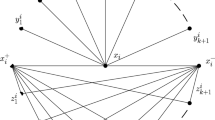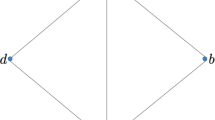Abstract
For a given simple graph \(G=(V,E)\), a latency bound t and a threshold function \(\theta (v)=\lceil \rho d(v)\rceil \), where \(\rho \in (0,1)\) and d(v) denotes the degree of the vertex \(v(\in V)\), a subset \(S\subseteq V\) is called a strong target set if for each vertex \(v\in S\), the number of its neighborhood in S not including itself is at least \(\theta (v)\), and all vertices in V can be activated by S through a process with t rounds. Initially, all vertices in S become activated. At the ith round of the process, each vertex is activated if the number of active vertices in its neighbor after \(i-1\) rounds exceeds its threshold. The \(t\)-Latency Bounded Strong Target Set Selection (t-LBSTSS) problem is to find such a strong target set S with the minimum cardinality in G. In general graphs, the t-LBSTSS problem is not only NP-hard, but also hard to be approximated. The aim of this paper is to find an optimal t-latency bounded strong target set for some special family of graphs. For a given simple graph G, a simple, tight but nontrivial inequality in terms of the number of edges in G is proposed to obtain the lower bound of the sum of degrees in a strong target set S to the t-LBSTSS problem. Moreover, a necessary and sufficient condition is presented for equality to hold. Finally, we give the exact formulas for the optimal solutions to the t-LBSTSS problem in two kinds of natural family of graphs, while it seems difficult to tell without the inequality given in this paper.


Similar content being viewed by others
References
Ackerman E, Ben-Zwi O, Wolfovitz G (2010) Combinatorial model and bounds for target set selection. Theor Comp Sci 411:4017–4022
Ben-Zwi O, Hermelin D, Lokshtanov D, Newman I (2011) Treewidth governs the complexity of target set selection. Discret Optim 8:87–96
Chang C, Lyuu Y (2010) Bounding the number of tolerable faults in majority-based systems. In: International Conference on Algorithms and Complexity. pp 109–119
Chen N (2009) On the approximability of influence in social networks. SIAM J Discrete Math 23:1400–1415
Chiang CY, Huang LH, Huang WT, Yeh HG (2011) The Target Set Selection Problem on Cycle Permutation Graphs, Generalized Petersen Graphs and Torus Cordalis, arXiv: 1112.1313
Chiang CY, Huang LH, Li BJ, Wu JJ, Yeh HG (2013) Some Results on the Target Set Selection Problem. J Comb Optim 25:702–715
Chiang CY, Huang LH, Yeh HG (2013) Target set selection problem for honeycomb networks. SIAM J Discrete Math 27(1):310–328
Chopin M, Nichterlein A, Niedermeier R, Weller M (2014) Constant thresholds can make target set selection tractable. Theory Comput Syst 55(1):61–83
Cicalese F, Cordasco G, Gargano L, Milanič M, Vaccaro U (2014) Latency–Bounded target set election in social networks. Theor Comp Sci 535:1–15
Diestel R (2005) Graph theory. Springer-Verlag, Heidelberg, New York
Dinh TN, Dung T, Nguyen DT, Thai MT (2012) Cheap, Easy, and Massively Effective Viral Markeing in Social Networks: Truth or Fiction? In: ACM conference on Hypertext and social media, pp 65-174
Domingos P, Richardson M (2001) Mining the network value of customers, In: Proceeding of the seventh ACM SIGKDD international conference on knowledge discovery and data mining, pp 57-66
Flocchini P, Kralovic R, Ruzicka P, Roncato A, Santoro N (2003) On time versus size for monotone dynamic monopolies in regular topologies. J Discrete Algo 1:129–150
Kaminski M, Lozin VV, Milanic M (2009) Recent developments on graphs of bounded Clique-width. Discrete Appl Math 157(12):2747–2761
Karimi F, Holme P (2013) Threshold model of cascades in temporal networks. Phys A: Stat Mech Appl 392(16):3476–3483
Kempe D, Kleinberg JM, Tardos E (2015) Maximizing the spread of influence through a social network. Theory Comput 11(4):105–147
Kempe D, Kleinberg JM, Tardos E (2005) Influential nodes in a diffusion model for social networks. Languages and Programming, Automata, pp 1127–1138
Khoshkhah K, Soltani H, Zaker M (2012) On dynamic monopolies of graphs: the average and strict majority thresholds. Discrete Optim 9:77–83
Liu XL, Yang ZS, Wang W (2013) Exact solutions for Latency–Bounded target set selection problem on some special families of graphs. Discrete Appl Math 2016:111–116
Nichterlein A, Niedermeier R, Uhlmann J, Weller M (2013) On tractable cases of target set selection. Soc Netw Anal Min 3(2):233–256
Peleg D (2002) Local majorities, coalitions and monopolies in graphs: a review. Theor Comp Sci 282:231–257
Zaker M (2012) On dynamic monopolies of graphs with general thresholds. Discrete Math 312:1136–1143
Zhang W, Wu W, Wang F, Xu K (2012) Positive influence dominating sets in power-law graphs. Soc Netw Anal Min 2:31–37
Zou F, Zhang Z, Wu WL (2009) Latency–Bounded minimum influential node selection in social networks. Lect Notes Comp Sci 5682:519–526
Author information
Authors and Affiliations
Corresponding author
Additional information
Publisher's Note
Springer Nature remains neutral with regard to jurisdictional claims in published maps and institutional affiliations.
This work is supported by the National Natural Science Foundation of China (Nos. 11701236, 11471005 and 11971376).
Rights and permissions
About this article
Cite this article
Liu, X., Yang, Z. & Wang, W. The t-latency bounded strong target set selection problem in some kinds of special family of graphs. J Comb Optim 41, 105–117 (2021). https://doi.org/10.1007/s10878-020-00671-4
Accepted:
Published:
Issue Date:
DOI: https://doi.org/10.1007/s10878-020-00671-4




